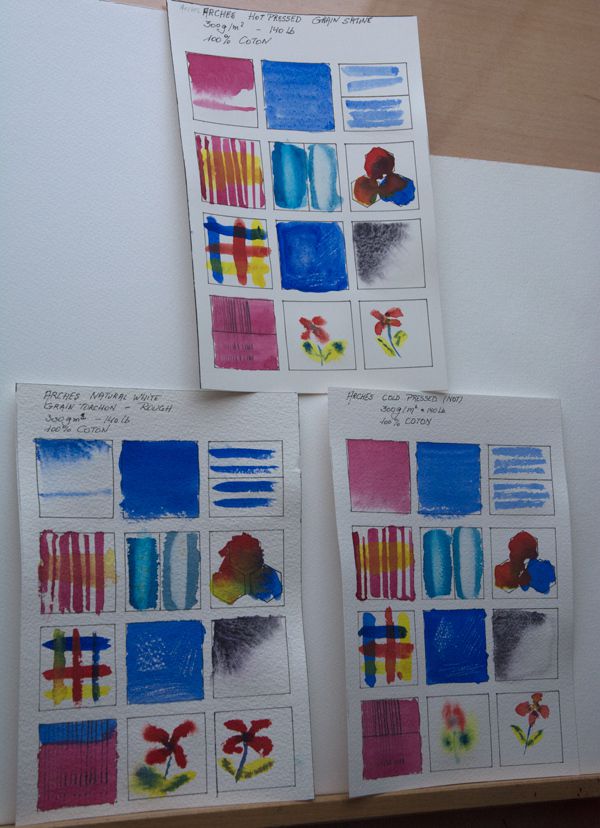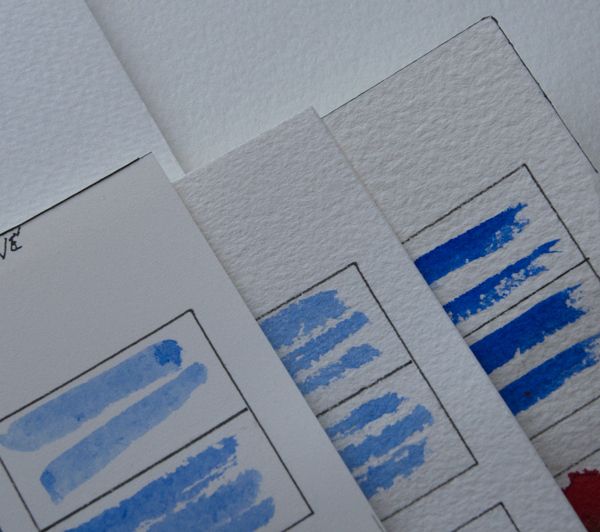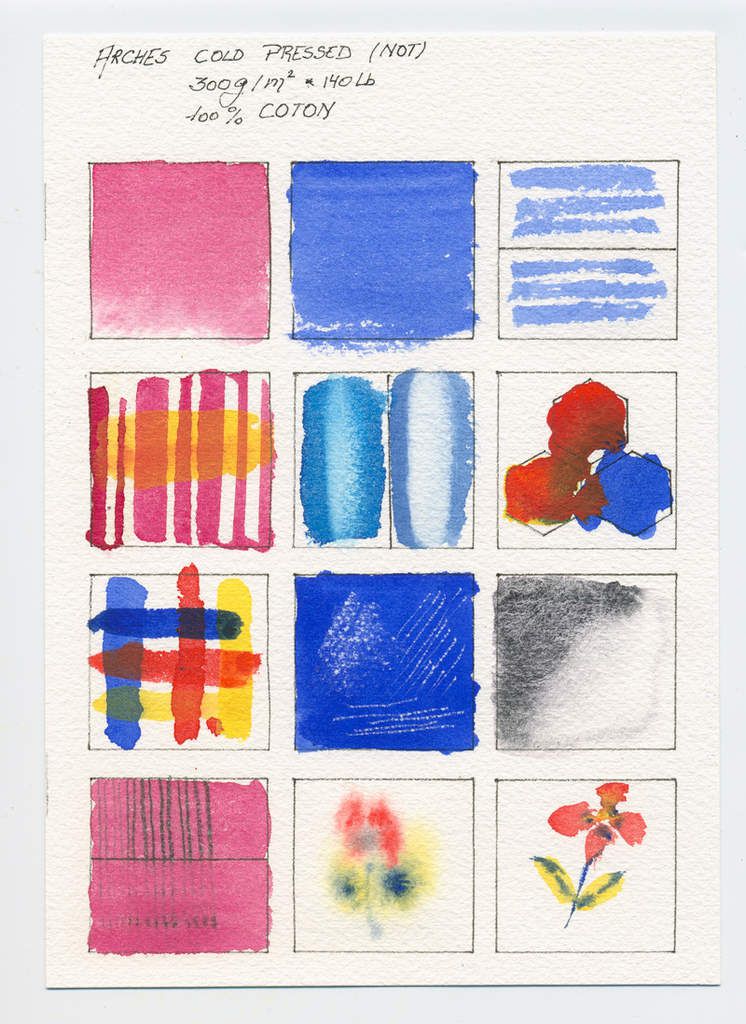Canson is the leader in France for producing artist quality papers. Until shortly the brand offered a large choice of watercolour papers. Composed with the brands Le Moulin du Roy (not the same as le Moulin du Coq), Fontenay, Acuarela Guarro, Vidalon, Montval and XL Aquarelle, the only paper type that wasn’t in the offer was a real superior quality paper and to beat it’s rival Arches, Canson launched l’Aquarelle Héritage, to open new horizons for top quality in watercolour.

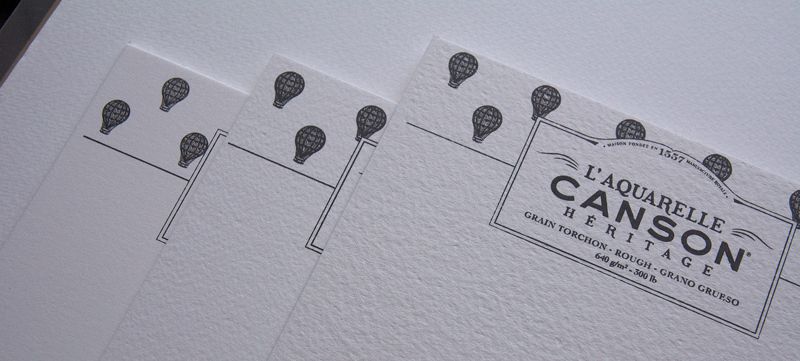
L’Aquarelle Canson® Héritage is the quintessence of almost 500 years of know-how associated with all the latest technological advances in papermaking:
- Strong and absorbent; 100% cotton
- Mould-made for a sensual texture and strength
- An innovative sizing ensures uniform washes without accumulation of pigments. Colors are bright and vivid. Allows for ultra sharp brush strokes without smudges
- Easy to correct whether wet or dry
- An optimised working time: The paper remains at peak saturation longer giving the artist ample time to work larger areas
Weight or thickness
300 et 640 gsm / 140 and 300 Lb
Colours and textures
3 available textures: cold pressed (NOT), hot pressed, rough grain
Formats
Sheet: 56 x 76 cm
Roll: (Only in 300 gsm) : 1,52 x 4,57 m
One side glued pad: 23 x 31 cm, 26 x 36 cm.
Four side glued pad: 23 x 31 cm, 26 x 36 cm, 31 x 41 cm, 36 x 51 cm.
Only in cold pressed: 18 x 26 cm & 46 x 61 cm
Standard & Longevity guarantee
Complies with ISO Standard 9706, acid-free and without optical brightness additives.

So i was really curious to see how the Heritage paper behaves, special against the Arches paper. So i tested the 300g and 640g. It’s also very interesting to compaire this paper with the Moulin du Roy ( The King’s Mill) as both papers are cylinder mould and 100% coton.
So the next test within a few days to be published will be the Canson Moulin du Roy and then i will follow with Lanaquarelle (an other very appreciated paper in France). Fabriano, Hahnemuhle … will follow later.
Please subscribe to my blog by putting you email in the box and you’ll receive a post when an new article will be posted.
Have a nice lecture and comparison and don’t hesitate to contact me if you have questions or remarks.
So let see how it turns out…
Canson Héritage Hot Pressed 300g /140 Lb - 640g/300Lb

General observation :
The paper has a natural White color, with a light warm undertone, but is a little bit more white than Arches . Surface is smooth, but a bit rougher than the competitors. Paper curls and bubbles a little , It curls in a cylindric form and slightly bubbles. I notice that the surface is rougher than other hot pressed paper, may be the sizing is different ? Stretching is recommended when one does heavy wet in wet washes. The 640g doesn’t need any stretching as it stay plane.
- Wet in Wet: The paint disperses equally on the whetted paper. You can’t see the small line, it dissolves nearly entirely . You can see that the dispersion of the paint is more pronounced in the 640g paper than for the 300g.
- Wet on Dry : I noticed that the paper absorbs well the water. We can hardly see brushmarks and the wash is very nice.I used a N°8 Escoda Kolinsky charged brush, and the paint hold in the brush was able to paint all the area (Arches absorbs more and that’s why i couldn’t finish painting all the square, because the brush ran out of paint).
- Dry on Dry : There is a quite a difference between the dry and the pre-wetted area. The lines are different and the borders are more crisp. The treated paper has also a much rougher touch than the non watered area. On the non threaded area the wash is even and the edges are crisp. On the pre-wetted area we can see that the wash is more uneven and that the edges are irregular.
- Tape and Masking Fluid : The masking fluid and the tape have damaged the paper. The over painting shows a difference in absorption and result as we could have noticed in the pre-wetted area with the brush strokes.
- Lifting : Notice a quite good lift of the Cerulean Blue specially on the 640g paper. The Phtalo blue area show lesser lifting. Although masking harms the paper, lifting doesn’t. So one can insist a lot before paper is damaged.
- Mixing : As seen in the wet in wet section we can see here nice dispersion of the fluid so that colours travels a lot and push each other with moderate mixing.

Canson Héritage Cold Pressed - NOT 300g /140 Lb - 640g/300Lb
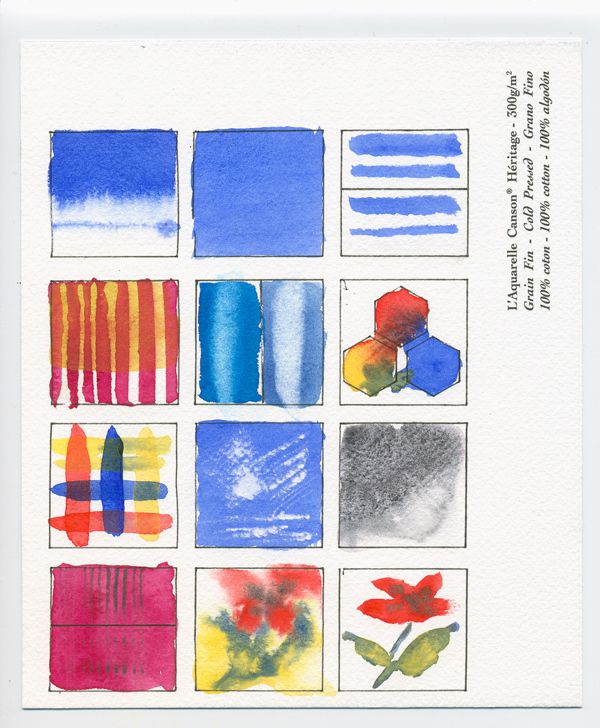
- Wet in Wet: The paint disperses equally on the whetted paper. You can’t see the small line, it dissolves nearly entirely . You can see that the dispersion of the paint is more pronounced in the 640g paper than for the 300g paint, although it disperses well and smoothly. You can’t see the small line that has dissolves entirely.
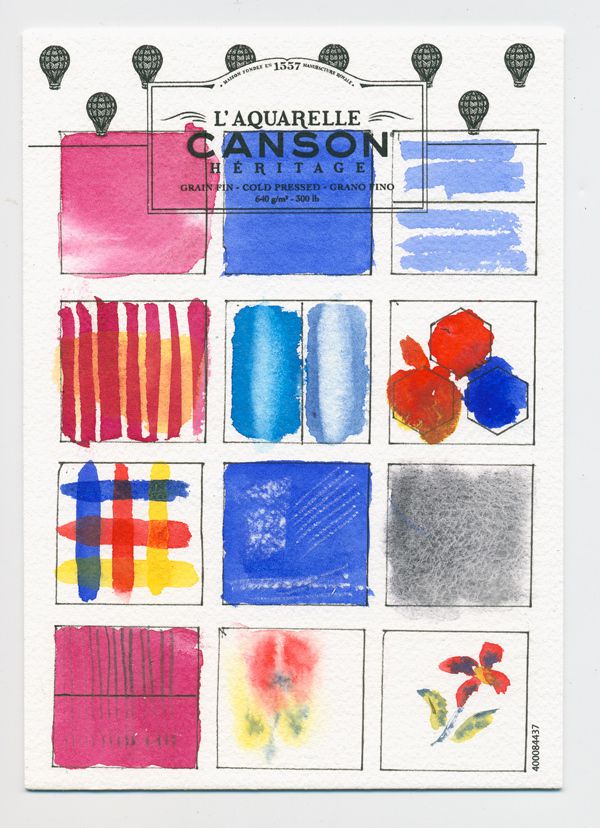
- Wet on Dry : We can hardly see brushmarks and the wash is very nice.I used a N°8 Escoda Kolinsky charged brush, and the paint hold in the brush was able to paint all the area (Arches absorbs more and that’s why i couldn’t finish painting all the square… the brush ran out of paint)..
- Dry on Dry : There is a quite a difference between the dry and the pre-wetted area. The lines are different and the borders are more crisp. The treated paper has also a much rougher touch than the non watered area. On the non threaded area the wash is even and the edges are crisp. On the pre-wetted area we can see that the wash is more uneven and that the edges are irregular.
- Tape and Masking Fluid : Opposite to the damage sensitive behaviour of the hot pressed paper, the masking fluid and the tape haven’t damaged the paper. The over painting shows a difference in absorption and result as we could have noticed in the pre-wetted area with the brush strokes..
- Lifting : Notice a quite good lift of the Cerulean Blue specially on the 640g paper. The Phtalo blue area shows lesser lifting. Although masking can harms the paper, lifting doesn’t. So one can insist a lot before paper is damaged.
- Mixing : As seen in the wet in wet section we can see here nice dispersion of the fluid so that colours travels a lot and push each other with moderate mixing.
- Layering : Layering on this paper performs very well. There is nearly no mixing going on between the two layers.(Only on the 300g the blue and yellow did some mixing)
- Scratching : This paper doesn’t support quite well scratching ! Using flat side and sharp point of the x-acto knife damages the paper easily and tear of quite a bit of the top layer.
- Granulation : The granulation and spread is very nice creating very nice cloudy textures.
- Erasing : The kneaded eraser doesn’t lift all the graphite as does the standard and electric eraser. The over painted erased parts are equal in density and hue as the un-erased surface.
- Painting on wet paper : The paint disperse very nicely in the wetted area.
- Painting on dry paper : The edges and strokes are very crisp and mixing is nic
Conclusion :
This paper can be used for any painting style… but specially if you’re painting wet in wet. Watercolour can express itself entirely in a wet area on this paper as flow, disperse and on paper mixing are the speciality of this Heritage Cold Pressed paper. But take a special attention before using masking fluid and masking tape, as the paper cam be damaged easily ! Some reserve for scratching …
I don’t advice to use very wet 300g paper without stretching as it will not stay flat.
PRICE 300g/140Lb
Sheet 56 x 76 cm - 22 x 30 in …. 5.50 £ - 7,20 $
Glued Blockxs 31 x 41 cm - 12 x 16 in …. 47.00 £ - 57.00 $
PRICE 640g/300Lb
Sheet 56 x 76 cm - 22 x 30 in …. 10.90 £ - - $ (not found)
Canson Héritage Rough 300g /140 Lb - 640g/300Lb

General observation : The paper has a natural White color, with a light warm undertone, but is a little bit more white than Arches . Surface is not to pronounced textured, but a texture is more spread than on Arches. Paper curls and bubbles a little , It curls in a cylindric form and slightly bubbles. Stretching is recommended when one does heavy wet in wet washes. The 640g doesn’t need any stretching as it stay flat.
- Wet in Wet: The paint disperses equally on the whetted paper. You can’t hardly see the small line, it dissolves nearly entirely . You can see that the dispersion of the paint is more pronounced in the 640g paper than for the 300g paint, although it disperses well and smoothly. You can’t see the small line that has dissolves entirely.
- Wet on Dry : We can hardly see brush marks and the wash is very nice and even. I used a N°8 Escoda Kolinsky charged brush, and the paint hold in the brush was able to paint all the area (Arches absorbs more and that’s why i couldn’t finish painting all the square… the brush ran out of paint)..
- Dry on Dry : There is a quite a difference between the dry and the pre-wetted area. The lines are different and the borders are more crisp. The treated paper has also a rougher touch than the non watered area. On the non threaded area the wash is even and the edges are crisp, it behaves as a rough paper should. It produces very nice texture in dry brush strokes. On the pre-wetted area we can see that the wash is more uneven but that dispersion is better. The edges are irregular.
- Tape and Masking Fluid : Opposite to the damage sensitive behaviour of the hot pressed paper, the masking fluid and the tape have only slightly damaged the paper. Due to texture, paint does crawl under certain parts of the masking tape.The over painting shows a difference in absorption and result as we could have noticed in the pre-wetted area with the brush strokes..
- Lifting : Notice a quite good lift of the Cerulean Blue specially on the 640g paper. The Phtalo blue area shows lesser lifting. Although masking can harms the paper, lifting doesn’t. So one can insist a lot before paper is damaged.
- Mixing : As seen in the wet in wet section we can see here nice dispersion of the fluid so that colours travels a lot and push each other with moderate mixing.
- Layering : Layering on this paper performs very well. There is nearly no mixing going on between the two layers.(Only on the 300g the blue and yellow did some mixing)
- Scratching : This paper doesn’t support quite well scratching ! Using flat side and sharp point of the x-acto knife damages the paper easily and tear of quite a bit of the top layer.
- Granulation : The granulation and spread is very nice creating very nice cloudy textures.
- Erasing : A rough surface is much more difficult to erase … The kneaded eraser doesn’t lift all the graphite as does the standard and electric eraser. The over painted erased parts are equal in density and hue as the unerased surface.

- Painting on wet paper : The paint disperse very nicely in the wetted area.
- Painting on dry paper : The edges and strokes are very crisp and mixing is nice
Conclusion :
This paper can be used for any painting style requiring use of texture… but recommended specially if you’re painting landscapes or modern wet in wet art. Watercolour can express itself entirely in a wet area on this paper as flow, disperse and on paper mixing are the speciality of this Heritage paper. The rough surface add a lot of texture to your artwork, but if you need detail and paint in a realistic style, this paper doesn’t suit you. Take a special attention before using masking fluid and masking tape, as the paper cam be damaged easily ! Some reserve for scratching …
I don’t advice to use very wet 300g paper without stretching as it will not stay flat.
PRICE 300g/140Lb
Sheet 56 x 76 cm - 22 x 30 in …. 5.50 £ - 7,20 $
Glued Blockxs 31 x 41 cm - 12 x 16 in …. 47.00 £ - 57.00 $
PRICE 640g/300Lb
Sheet 56 x 76 cm - 22 x 30 in …. 10.90 £ - - $ (not found)
PROS and CONS
PROS
- Absorbs fluid very well and stay wet a long time enabling painting wet in wet longer
- Dries also equally so that it limits back runs
- Creates very nice texture and granulation with granulation paint
- Mixing on paper is a pleasure
- Layering is very nice although some mixing can take place is paint is too wet or too charged.
- 100% coton (% rag not indicated) cylinder mould and archival quality
- The leadership of the brand
CONS
- The Price of this paper. More pricy than Arches. A real “Luxe” for wealthy artists an amateurs ...
- Not yet widely distributed. I didn’t find a retailer for the 640g/300Lb paper in the US
- The surface is quite fragile and masking can produce disasters as does scratching. But lifting performs well even with harder brushes.
I first tested Arches papers as a base for comparison. I’m looking forward to compaire Heritage with his “brother” Le Moulin du Roy, the former top paper from Canson. I did use this paper often in the past and it pleased me a lot.
Very soon afterwards i’ll post my test of Lanaquarelle papers (very appreciated brand in France) and later Fabriano, Hahnemuhle (big competitor for Canson), Bockingford, Winsor & Newton, Langford, Waterford and some artisans handmade papers too.
Special thanks to Denis Beaux Arts for the free samples that i received from them. This french web store sends worldwide you can visit their site using this link.
You can find full information on the Canson web site
You can buy Canson Heritage Papers using these links :

